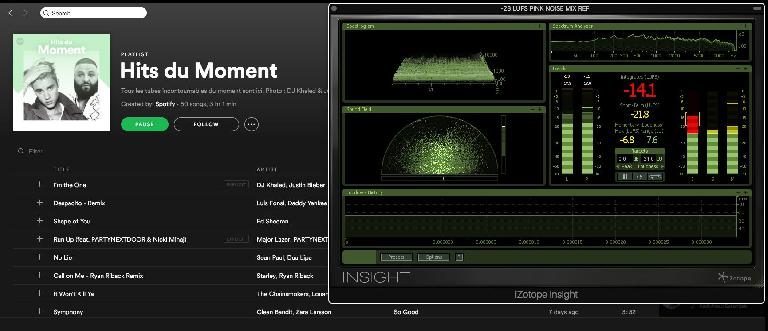It appears as if Spotify have decided to join the majority of online streaming platforms and reduce their streaming target loudness from -12 LUF to -14 LUFS! By my own measurements, a solid thirty to forty minutes of the Top 50 global playlist off the free Spotify app yields an integrated value of -14 LUFS with true peaks well below -1 dbTP*. Although, it is unclear as of this writing whether the new loudness targets are being met in all territories and may require updating to the latest version of Spotify.
Who cares?
Spotify has long been the outlier in terms of online loudness, streaming a full +4 LU (1 LU = 1dB) above AES recommended streaming practices of -16 LUFS/-1dBTP and causing no end of confusion in the last days of the loudness war. Audio luminaries such as Bob Katz, Thomas Lund, George Massenberg and many more have been working with streaming services to bring their normalization targets down to optimal levels.
-12 LUFS is way too loud - as explained in depth here; https://ask.audio/articles/how-loudness-standards-relate-to-edm-and-club-music-production -
So this move brings Spotify into the same Loudness ballpark as TIDAL who are normalising to no louder than -14 LUFS, YouTube who seem to be normalising high view count videos to -14 LUFS, and 2 LU higher than iTunes and iTunes radio with “Sound Check” loudness normalising to -16 LUFS.
If LUFS and LU’s still confuse you, catch up here: https://ask.audio/articles/demystifying-the-confusion-around-loudness-metering-levels
So what does this mean for electronic and indie music producers?
It means that you don’t have to care about your tracks being “loud” anymore. This is because as of now, most online streaming services are matching the perceived loudness of tracks to each other to a unified target level. So regardless of how much you worked on squeezing a few extra dB out of your hyper-compressed “master”, if an online streaming service measures your track as higher than -14 LUFS (integrated) YOUR MUSIC WILL GET TURNED DOWN!
Why is this an issue? Streaming through, or from, a mobile device is how most of your audience will engage with your music outside of Live/DJ sets, so optimising for streaming makes sense. Crucially, it is more beneficial to have a dynamic track turned up than to have a loud, compressed track turned down, so mixing and mastering above -14 LUFS for online audio is not a great idea.
Unfortunately for us electronic music makers we still have to deal with SoundCloud and Bandcamp, and neither service even seems to be aware of the loudness issues facing their content. SoundCloud and Bandcamp are a free-for-all at the moment with incredibly loud music being uploaded every day, and it sucks that dance and electronic music is the last bastion of the loudness war. Soundcloud was never built on its reputation for quality audio, but a target loudness value of -14 LUFS/ -1 dBTP is highly recommended regardless of your “competition’s levels”.
Counterintuitively, using this target level will optimize your files for playback from SoundCloud and other non-normalised services, and may improve your overall sound online, and when those services do adopt a loudness target your tracks are already primed and good to go.
Conclusion
It’s time to put Loudness for Loudness sake in the past where it belongs. Spotify’s -14 LUFS decision has positive, deep and wide ramifications for every tier of music production as integrated LUFS target levels take front and center. This means that music producers all over the world can stop fixating on extreme and unhealthy loudness targets and get back to making kick-ass dynamic music free from the damaging and awful sounding constraints of hyper compression.
Further Measurements
*Loudness expert Ian Shepherd and mastering engineer Sigurdór Guðmundsson have performed even more extensive checks on various playlists already and can confirm that many Spotify playlists are now conforming to -14 LUFS.



 © 2024 Ask.Audio
A NonLinear Educating Company
© 2024 Ask.Audio
A NonLinear Educating Company
Discussion
I look forward to the day that natural selection forces the issue on all music makers. As in "You can't present a track at -16 LUFS? You don't get played." That will normalize things really quick.
Ok..but I've been checking some releases ( charlie puth's attention, David guetta's flame, avicii's waiting for love) In Spotify, and all of them are -7/-6 lufs.
You mean if I send a track -14 ir so, they will raise it up to -7? I really don't think so..
I think muy track
I think my track will sound lower ...
Look, as an example, some time ago, I uploaded an unmastered track to Spotify.
Of course the track was -20 lufs or so..and you know what? It sounded really low In volumen..it didn't reach the others tracks..so that thing of normalisation isn't real In every case.
Were these done with Normalize Volume (in Spotify preferences) selected or not?
This is a critical detail.
Want to join the discussion?
Create an account or login to get started!